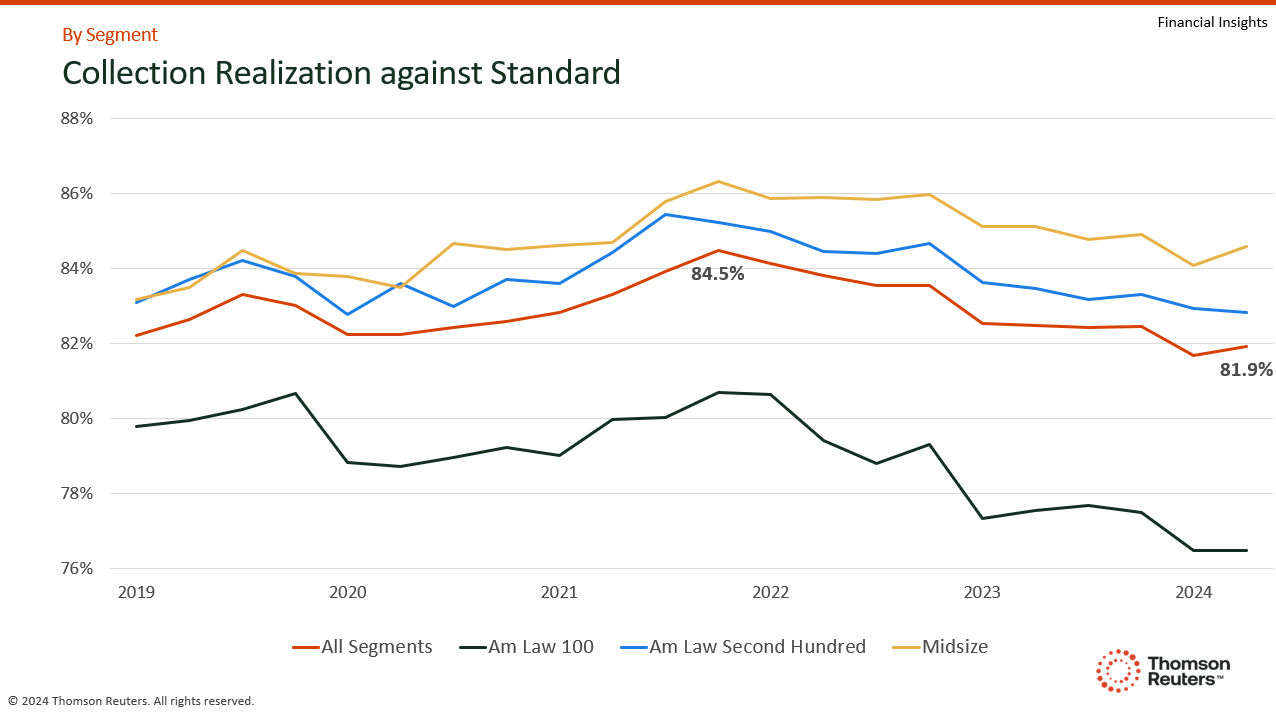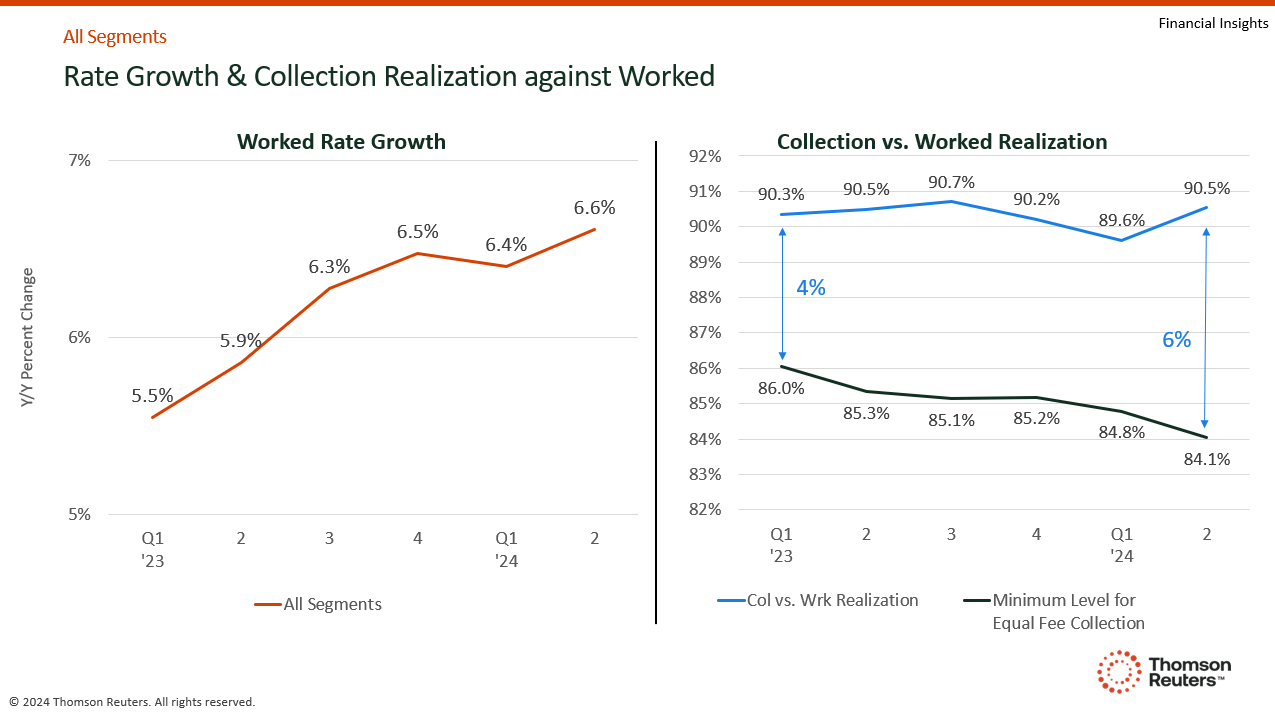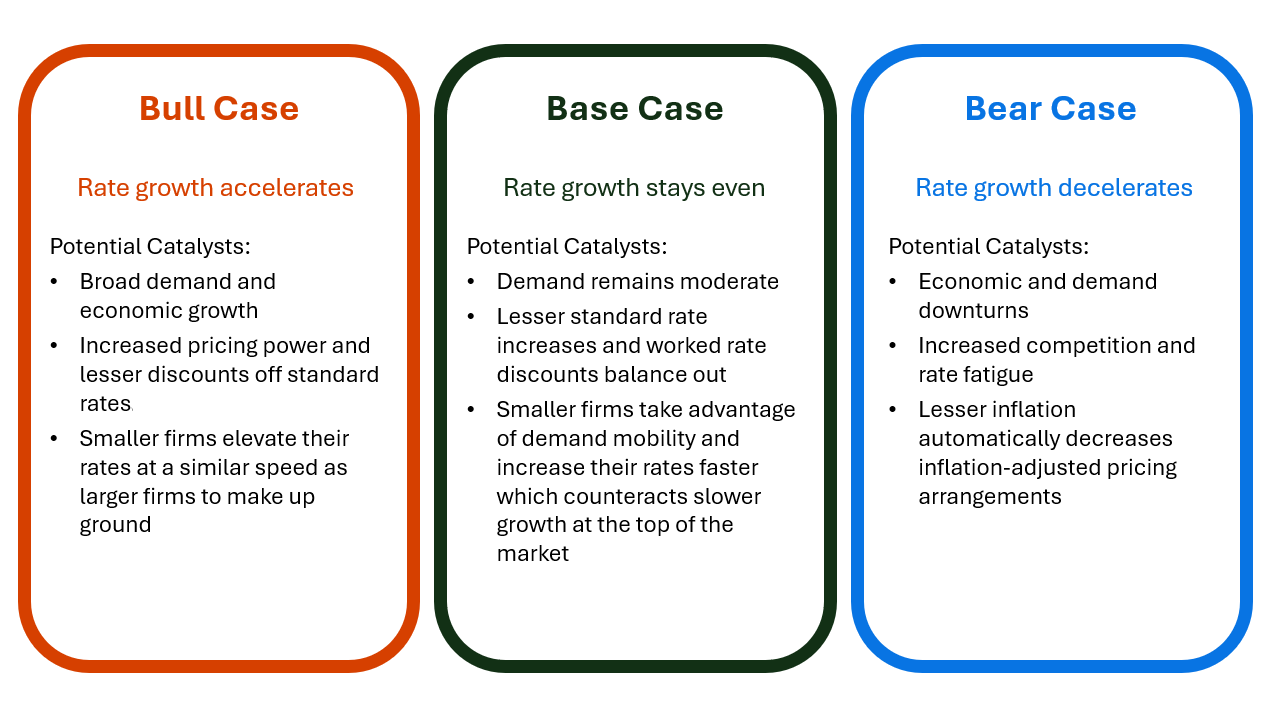How will 2025’s rapidly approaching new set of rates impact firms’ billing and collection strategies?
Over the past two years, law firms’ realization rates — the amount firms bill and collect from clients on legal services work — have broadly declined to levels more in line with pre-pandemic norms, and in some areas of the legal industry, these rates are even descending below those pre-pandemic levels.
Not surprisingly, this trend has been a significant concern for law firms across the industry. However, the Thomson Reuters Institute’s recent Law Firm Rates in 2024 report provided a compelling analysis that demonstrated how firms’ rapid rate growth has largely mitigated these declines, ultimately benefiting firms’ top lines.
As we look ahead to 2025, a new set of rates is quickly approaching, with negotiations between firms and clients still in full swing at the current time. This brings considerable uncertainty regarding the pace at which firms will push rate growth and places additional focus on the level of realization firms will need to maintain in order to continue to grow their revenues.
Indeed, how firms set their rates and manage their realization will play an enormous role in determining revenue targets for the end of 2025.
Rate growth & realization declines
Over the past two years, law firms have increased their worked rates at historic speeds, with 2023 seeing a 6% increase in rate growth, and 2024 YTD Q2 experiencing a 6.5% rise. To put this in perspective, the average pace of rate growth between 2010 to 2022 was 3.4% per year. This rapid rate growth has been the primary driver of revenue growth and has largely compensated for losses in realization rates since the pandemic era peaks. For instance, in Q4 2021, collection realization against standard rates was 84.5%, compared to Q2 2024’s rate of 81.9%.

The concept of rate growth compensating for realization losses can be encapsulated by a metric introduced in the Law Firm Rates in 2024 report called realization margin. This metric represents the gap between a firm’s actual realization and the level of realization needed for that firm to collect an equivalent amount of fees as in the previous period given their worked rate growth.
To illustrate, consider the right side of the chart in the figure below: In Q1 2024, law firms collected 89.6% of their worked fees, which meant that if a firm had $100 in fees worked, they would have collected $89.6. Shifting our attention to the left side of the chart, which shows worked rate growth, we see that in Q2 2024, rate growth was 6.6% meaning that the firm’s fees worked would now be $106.6 compared to the previous period. This means firms only needed to collect 84.1% of their fees worked to match the same collection amount as in Q1 2024 (this is because 84.1% of $106.6 equals $89.6). The 84.1% is represented by the dark green line labeled Minimum Level for Equal Fee Collection, which is considered the level the firm would need to reach to break even on collections.

In reality, firms collected 90.5% of their fees worked, indicating that the realization margin gap between actual collections and the minimum level for collections expanded. This expansion from Q1 2023 to Q2 2024 highlights the increasing power of rate growth as it accelerates. This also demonstrates that falling collection realization can be mitigated as rate growth accelerates.
While this may seem like we are saying that this trend diminishes the importance of realization, this only holds true if rate growth continues to accelerate faster than realization declines. As we look ahead to the new rate levels for next year, we can examine some potential implications for realization under bullish, bearish, and base case scenarios for rates.

Bull Case
In the bullish scenario, we anticipate continued robust rate growth, most likely exceeding historical averages. Law firms could see annual rate increases of 7% or higher. This sustained growth would likely be driven by strong demand for legal services, economic expansion, or firms’ ability to command higher fees or offer fewer discounts — or perhaps all three. Add to this the potential for firms to make the case to clients that their use of GenAI efficiencies and the resulting fewer billable hours could warrant a higher cost per matter, thereby continuing to fuel increased rate growth.
In the bullish scenario, even if realization rates remain stable or slightly decline, the rapid, potentially GenAI-driven rate growth would more than compensate for any continued slow decline in realization. Firms would experience revenue growth, driven by the compounding effect of higher rates and stable demand.
Base Case
In the base (or status quo) case, rate growth is expected to align more closely with current levels of increases being around 5% to 6%. Demand for legal services remains moderate, similar to recent years, and standard rate increases and worked rate discounts balance out. In this scenario, firms would need to focus on maintaining or slightly improving their realization rates to ensure continued revenue growth. Realization margin would play a critical role in law firms’ calculations, with firms needing to balance rate increases and collection efficiency. While the revenue growth may not be as dramatic as in the bullish case, it would still be positive, provided that firms manage their realization effectively.
Currently, 88.7% of firms in the United States have a collected vs. worked realization rate above 84.1% (the current minimum level for equal fee collection), which suggests that it is highly likely that sustaining the current level of worked rate growth will maintain or increase collections.
Bear Case
In the bearish scenario, rate growth slows significantly, falling below recent averages to a level more similar to the one seen in the 2010s with average growth of 3% to 4%. This could be due to economic downturns, increased competition, or clients’ increased scrutiny in negotiations. In this scenario, realization rates would become increasingly critical. Firms would need to maximize their collection realization to offset the more reduced rate growth. The realization margin would narrow, and firms would face pressure to improve their operational efficiency and client relationships to maintain revenue levels.
It’s likely that revenue growth would be modest or potentially negative, requiring many law firms to try to capture more market share or adopt more stringent measures to manage costs — or both.
Conclusion
Given the uncertainty surrounding future rate growth and realization margins, now is an opportune time for law firms to prepare for any potential change in the rate growth environment. By thoroughly evaluating and optimizing their internal practices, firms can better position themselves to navigate the complexities of the market, regardless of whether rate growth accelerates, remains steady, or slows down.
Proactive assessment and strategic scenario planning will be crucial to ensure that law firms can maintain and enhance their revenue streams, even amid an unpredictable landscape.
You can download a full copy of the Thomson Reuters Institute’s recent Law Firm Rates in 2024 report, here.







